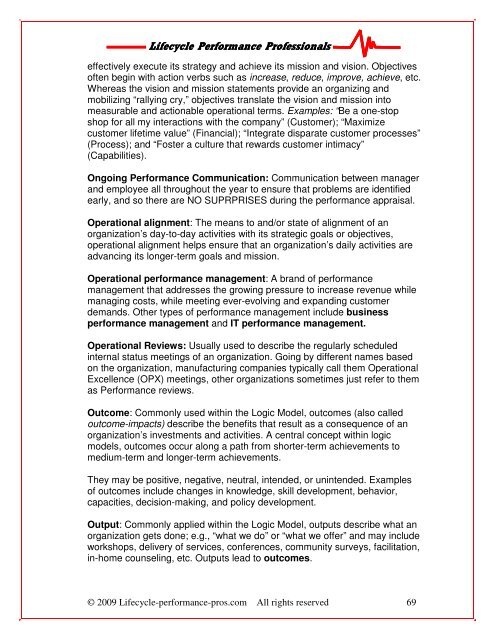Download the Performance Management Fundamentals Guide
Download the Performance Management Fundamentals Guide
Download the Performance Management Fundamentals Guide
You also want an ePaper? Increase the reach of your titles
YUMPU automatically turns print PDFs into web optimized ePapers that Google loves.
Lifecycle Lifecycle <strong>Performance</strong> <strong>Performance</strong> Professionals<br />
Professionals<br />
effectively execute its strategy and achieve its mission and vision. Objectives<br />
often begin with action verbs such as increase, reduce, improve, achieve, etc.<br />
Whereas <strong>the</strong> vision and mission statements provide an organizing and<br />
mobilizing “rallying cry,” objectives translate <strong>the</strong> vision and mission into<br />
measurable and actionable operational terms. Examples: “Be a one-stop<br />
shop for all my interactions with <strong>the</strong> company” (Customer); “Maximize<br />
customer lifetime value” (Financial); “Integrate disparate customer processes”<br />
(Process); and “Foster a culture that rewards customer intimacy”<br />
(Capabilities).<br />
Ongoing <strong>Performance</strong> Communication: Communication between manager<br />
and employee all throughout <strong>the</strong> year to ensure that problems are identified<br />
early, and so <strong>the</strong>re are NO SUPRPRISES during <strong>the</strong> performance appraisal.<br />
Operational alignment: The means to and/or state of alignment of an<br />
organization’s day-to-day activities with its strategic goals or objectives,<br />
operational alignment helps ensure that an organization’s daily activities are<br />
advancing its longer-term goals and mission.<br />
Operational performance management: A brand of performance<br />
management that addresses <strong>the</strong> growing pressure to increase revenue while<br />
managing costs, while meeting ever-evolving and expanding customer<br />
demands. O<strong>the</strong>r types of performance management include business<br />
performance management and IT performance management.<br />
Operational Reviews: Usually used to describe <strong>the</strong> regularly scheduled<br />
internal status meetings of an organization. Going by different names based<br />
on <strong>the</strong> organization, manufacturing companies typically call <strong>the</strong>m Operational<br />
Excellence (OPX) meetings, o<strong>the</strong>r organizations sometimes just refer to <strong>the</strong>m<br />
as <strong>Performance</strong> reviews.<br />
Outcome: Commonly used within <strong>the</strong> Logic Model, outcomes (also called<br />
outcome-impacts) describe <strong>the</strong> benefits that result as a consequence of an<br />
organization’s investments and activities. A central concept within logic<br />
models, outcomes occur along a path from shorter-term achievements to<br />
medium-term and longer-term achievements.<br />
They may be positive, negative, neutral, intended, or unintended. Examples<br />
of outcomes include changes in knowledge, skill development, behavior,<br />
capacities, decision-making, and policy development.<br />
Output: Commonly applied within <strong>the</strong> Logic Model, outputs describe what an<br />
organization gets done; e.g., “what we do” or “what we offer” and may include<br />
workshops, delivery of services, conferences, community surveys, facilitation,<br />
in-home counseling, etc. Outputs lead to outcomes.<br />
© 2009 Lifecycle-performance-pros.com All rights reserved 69










